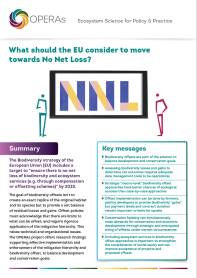Europe has successfully established a network of protected sites (Natura 2000) and protected many species of threatened fauna and flora. There is however a policy gap in the wider environment, where the conversion and fragmentation of habitats and the intensification of land use shows no sign of letting up. This a reason why the decline and loss of species has not (yet) been stopped in the EU. One solution is to introduce and implement policies that strengthen or expand requirements to avoid, mitigate and, if necessary, offset impacts on biodiversity and ecosystem services, in the wider environment. There is already much experience across Europe with such requirements, and a growing shift towards achieving no net loss (or a net gain) of biodiversity where residual impacts are unavoidable.
Policy Brief
 Download a PDF of the OPERAs Policy Brief
Download a PDF of the OPERAs Policy Brief
What should the EU consider to move towards No Net Loss (NNL)?
Links and resources
- Report on No Net Loss policy options for the EU and extensive annexes
- A tool to meet EU’s no net loss requirement?
References
- Calvet C., Le Coënt P., Napoléone C. & Quétier F. (2017): Challenges of achieving biodiversity offset outcomes through agri-environmental schemes: evidence from an empirical study in Southern France. LAMETA Working Paper, Laboratoire Montpelliérain d’Economie Théorique et Appliquée, Montpellier, France.
- Gaucherand S., Schwoertzig E., Clément J.C., Johnson B. & Quétier F. (2015): The cultural dimensions of freshwater wetland assessments: lessons learned from the application of US rapid assessment methods in France. Environmental Management 56(1), 245-259.
- Jacob, C., Vaissière, A-C., Bas, A., Calvet, C. (2016b). Investigating the inclusion of ecosystem services in biodiversity offsetting. Ecosystem Services, 21, 92-102.
- Quétier, F., Van Teeffelen, A. J. A., Pilgrim, J. D., von Hase, A., & ten Kate, K. (2015a). Biodiversity offsets are one solution to widespread poorly-compensated biodiversity loss - a response to Curran et al. Ecological Applications, 25(6), 1739–1741.
- Quétier F., Moura C., Menut T., Boulnois R. & Rufray X. (2015b): La compensation écologique fonctionnelle : innover pour mieux traiter les impacts résiduels des projets d’aménagements sur la biodiversité. Sciences, Eaux et Territoires 17, 24-29
- Scholte, S. S. K., van Zanten, B. T., Verburg, P. H., & van Teeffelen, A. J. A. (2016). Willingness to offset? Residents’ perspectives on compensating impacts from urban development through woodland restoration. Land Use Policy, 58, 403–414.
- Schulp, C. J. E., Van Teeffelen, A. J. A., Tucker, G., & Verburg, P. H. (2016). A quantitative assessment of policy options for no net loss of biodiversity and ecosystem services in the European Union. Land Use Policy, 57, 151–163.
- Vaissière A.C., Bierry A. & Quétier F. (2016a): Mieux compenser les impacts sur les zones humides : modélisation de différentes approches dans la région de Grenoble. Sciences, Eaux et Territoires 21, 64-69.
- Vaissière A.C., Tardieu L., Quétier, F. & Roussel S. (2016b): Preferences for Biodiversity Offset Contracts on Arable Land: A Choice Experiment Study with farmers. Working paper, French Association of Environmental and Resource Economists (FAERE).
- van Teeffelen, A. J. A., Opdam, P., Watzold, F., Hartig, F., Johst, K., Drechsler, M., Vos, C.C., Wissel, S. & Quétier, F. (2014). Ecological and economic conditions and associated institutional challenges for conservation banking in dynamic landscapes. Landscape and Urban Planning, 130, 64–72.
Webinar: Natural capital and ecosystem services in research, policy and practice
The fifth in the six-part series of OPERAs' webinars, took place on Thursday 12 October 2017. You can watch the recording below or on the Oppla YouTube channel.
